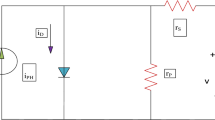Abstract
To reach the increasing demand for power quality and power rating along with lower harmonic distortion and lesser electromagnetic interference, the multilevel inverter is needed. Solar energy is one of the favorable renewable energy resources, and the multilevel inverter has been proven to be one of the important enabling technologies in photovoltaic utilization. This paper is based on the study of behavior of a nine levels NPC three-phase inverter topology interfacing multistring photovoltaic system to the electric grid. This inverter is controlled by the pulse-width modulated strategy. Eight carrier waves of the same frequency and different amplitudes are compared with two references (a sine wave and its opposite) for generating the control signals of the switches. Some DC/DC boost converters are used to amplify the voltage produced by the photovoltaic generators. Each of these converters is controlled by a fuzzy Logic-based maximum power point tracking algorithm (FLBMPPTA) in order to track the maximum power point of the GPV; results of simulation in Matlab environment are given and discussed.































Similar content being viewed by others
References
Vijay Kumar MG, Manjunath D, Patil Anil W (2012) Comparison of multilevel inverters with PWM control method. Int J IT Eng Appl Sci Res (IJIEASR) 1(3), ISSN: 2319-4413
Desconzi MI, Beltrame RC, Rech C, Schuch L, Hey HL (2010) Photovoltaic Stand-Alone Power Generation System with Multilevel Inverter. In: International Conference on Renewable Energies and Power Quality (ICREPQ’11), Las Palmas de Gran Canaria (Spain), 13th to 15th April
Jacobs IS, Bean CP. World energy statistics—2009. International Energy
Liserre M, Sauter T, Hung JY (2010) Future energy systems: integrating renewable energy sources into the smart power grid through industrial electronics. IEEE Ind Electron Mag 4(1):18–37
Hansen AD et al (2000) Models for standalone PV systems. Report Riso- R-1219(EN) SEC. RNL, Roskilde, Denmark
Castaner L, Silvester S (2002) Modeling photovoltaic systems using PSPICE. Wily, 1ère Édition ISBN 0-470-84528-7
Celik AN, Acikgoz N (2007) Modeling and experimental verification of the operating currents of mono-cristalline photovoltaic modules using four and five parameters models. Appl Energy 84(1):1–15
Marrakchi A, Kammoum S, Sallem S, Kammoum M (2015) A practical technique for connecting PV generator to single-phase grid. Sol Enegy 118:145–154
Graham D, Lathrop RC (1953) The synthesis of optimum transient response: criteria and standard forms. Trans Am Inst Electr Eng Part 2 Appl Ind 72(5):273–288
Terki A, Moussi A, Betka A, Terki N (2012) An improved efficiency of fuzzy logic control of PMBLDC for PV pumping system. Appl Math Model 36(3):934–944
Lee CC (1990) Fuzzy logic in control systems: fuzzy logic controller—parts I and II. IEEE Trans Syst Man Cybern 20(2):404–435
Mechouma Rabiaa, Azoui Boubekeur (2014) Multiple low frequency dual reference PWM control of a grid connected photovoltaic three phase NPC inverter with DC/DC boost converter. Serbian J Electr Eng (SJEE) 11(2):315–337
Author information
Authors and Affiliations
Corresponding author
Appendix
Appendix
Parameters of ENIESOLAR module used in this work.
“ENIESOLAR” is a solar panel manufactured by the company National Electronic Industries in Algeria, which characteristics are given as follows:
Parameter | Value |
|---|---|
Maximal power | 75W, \(+/-\) 10% |
Short-circuit current \({I}_{\mathrm{SC}}\) | 4.67 A |
Open-circuit voltage \({V}_{\mathrm{OC}}\) | 21.6 V |
MPP voltage \({V}_{\mathrm{MPP}}\) | 17.30 V |
MPP current \({I}_{\mathrm{MPP}}\) | 4.34 A |
Minimum value of the fuse in series | 10 A |
Number of cells in series | 36 |
Number of cells in parallel | 1 |
Rights and permissions
About this article
Cite this article
Mechouma, R., Mebarki, H. & Azoui, B. Behavior of nine levels NPC three-phase inverter topology interfacing photovoltaic system to the medium electric grid under variable irradiance. Electr Eng 100, 2129–2145 (2018). https://doi.org/10.1007/s00202-018-0687-7
Received:
Accepted:
Published:
Issue Date:
DOI: https://doi.org/10.1007/s00202-018-0687-7




